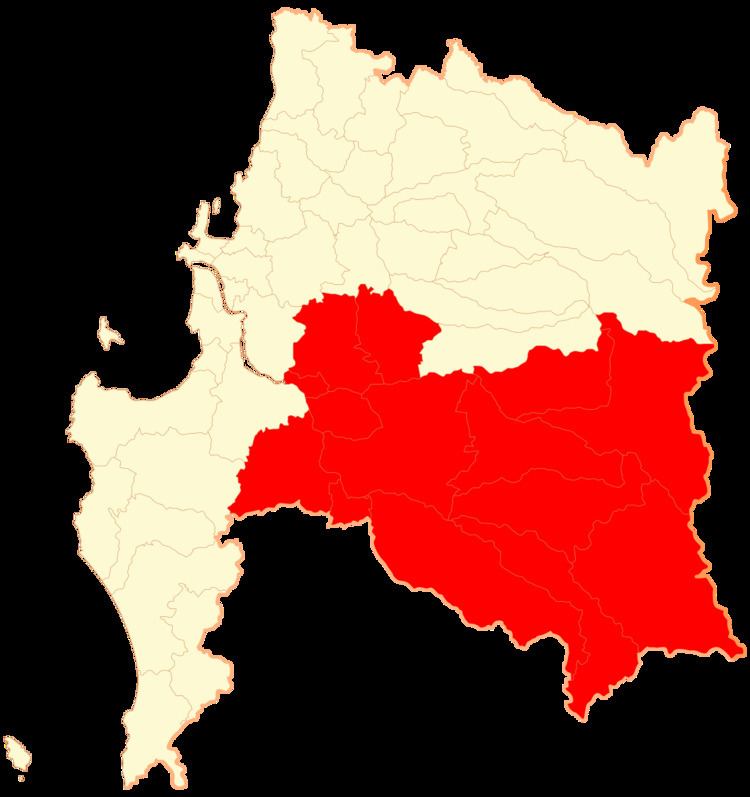Country Chile Time zone CLT (UTC-4) Website Government of Bío Bío Capital Los Ángeles | Region Bío Bío Area code(s) 56 + 43 Area 14,988 km² | |
 | ||
Points of interest Laja Falls, Laguna del Laja National, Laja Lake, Artequin Los Angeles, Antuco Destinations Los Ángeles, Alto Bío Bío, Antuco - Chile, Laguna del Laja National, Yumbel | ||
Bío Bío Province (Spanish: Provincia de Bío Bío) is one of four provinces of the Chilean region of Bío Bío (VIII). Its capital is Los Ángeles (2002 pop. 94,716). It is bounded on the north, west and south by the provinces of Concepción, Arauco and Malleco, respectively, and on the east by Argentina. It has an area of 14,987.9 km2 (5,787 sq mi) of well-wooded and mountainous country, and exports timber to a large extent. The population is 373,981 according to the census of 2012.
Contents
- Map of BC3ADo BC3ADo Province BiobC3ADo Chile
- History
- Administration
- Communes
- Geography and demography
- Bo Bo Valley wine region
- Grape distribution by varietal
- References
Map of B%C3%ADo B%C3%ADo Province, Biob%C3%ADo, Chile
The great trunk railway from Santiago south to Puerto Montt crosses the western part of the province and also connects it with the port of Concepción. Los Ángeles lies 25 km (16 mi) east of this railway and is connected with it by a branch line.
History
The Province of Bio-Bío was created on October 13, 1875, as part of the Province of Araucan. In 1887, President José Manuel Balmaceda set aside the Province of Malleco. The province was then named for the Bio-Bio River which flows through it. The Province of Bío Bío was divided, into three departments:
As part of the process of regionalization in the 1970s, the Region of Bío Bío was created. By Decree #1,213 of 27 of November 4, 1975, the VIII Region comprises the provinces of Bío Bío, Arauco, Concepción and Ñuble.
Administration
As a province, Bío Bío is a second-level administrative division of Chile, governed by a provincial governor who is appointed by the president.
Communes
The province is composed of 14 communes, each governed by a municipality consisting of an elected alcalde and municipal council.
Geography and demography
According to the 2002 census by the National Statistics Institute (INE), the province spans an area of 14,987.9 km2 (5,787 sq mi) and had a population of 353,315 inhabitants (176,960 men and 176,355 women), giving it a population density of 23.6/km2 (61/sq mi). It is the tenth most populated province in the country. Of these, 245,775 (69.6%) lived in urban areas and 107,540 (30.4%) in rural areas. Between the 1992 and 2002 censuses, the population grew by 9.1% (29,405 persons).
Bío Bío Valley wine region
The Bío Bío Valley wine region is located in the province and region of the same name. One of Chile’s southern wine regions, it has become known for its crisp, aromatic wines. The region is located at a latitude of 36°S, similar to southern Spain and Monterey in California. The majority of its vineyards lie between 50 and 200m (150 ft and 600 ft) above sea level with a moderate Mediterranean climate. It receives 1,275 mm (50.2 in) of rain per year, among the highest of all Chilean wine valleys, although winds prevent excessive humidity - a phenomenon that can also be observed in northern France. For most of 20th century, the main varieties grown in the Bío Bío valley were Moscatel de Alejandria and Pais (known as Missiones in USA), but today, Pinot Noir, Chardonnay, and Sauvignon Blanc are also grown throughout the valley.
Grape distribution by varietal
Total hectares planted: 446 ha (1102 acres)
